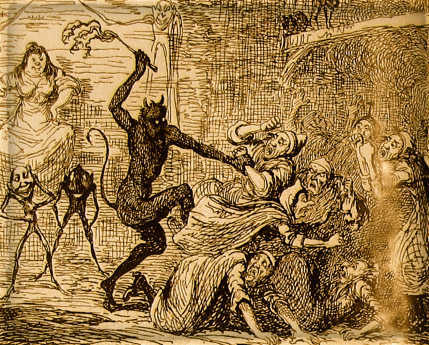West German Witchcraft Allegations

Whether this can help us understand Qanon or not, I have no real opinion. But this story of the West German witchcraft allegations of the early 1950s is downright fascinating and I knew absolutely nothing about it.
Doing research in a branch of the state library in Berlin a few years ago, I stumbled across a reference to a 1951 book called Are There Witches among Us? It had been published in West Germany by a former schoolteacher named Johann Kruse. The title puzzled me, and I assumed the book must be satirical: it couldn’t really be about fears of witches in post-World War II Germany. But surprisingly enough, it was. So I started researching what Kruse called “the modern witch craze.” He was profoundly preoccupied with the social impact of witchcraft accusations, a wave of which crashed over his country in the years just after 1945.
During that period, dozens of what the press referred to as “witchcraft trials” took place. In these cases, the person accused of witchcraft was not the one on trial, as would have been true in Europe in the sixteenth or seventeenth centuries. In the witch trials of the 1950s, the person on trial was the one doing the accusing; and the accusers were often tried for defamation, though also sometimes for more serious charges.
Fears of witchcraft are generally assumed to belong firmly to Europe’s past and are most closely associated with the wide-scale witch hunts that took place during what historians call the early modern period. Yet people accusing each other of being witches never really went away. It simply no longer resulted in clerically or juridically led investigations or executions. Witch fears endured in many parts of Europe, as they have in other parts of the world. But what caused a great spike in accusations after Germany’s defeat in WWII and the destruction of the Third Reich?
Unlike earlier European witch scares, postwar West German witchcraft accusations did not involve carnal relations with the Devil, nocturnal flight, or being able to fall down stairs without sustaining injury. Though they imputed magical evildoing, the accusations mostly involved more mundane human problems, like suspicion, resentment, and festering doubt.
This characteristic aligns with what anthropologists and historians who work on comparative witchcraft have made clear: that while witch fears can take quite different forms across geography and time period, they are often related to matters of intimacy and mistrust, and they erupt in response to instability, insecurity, and unease—moments very much like the one that followed World War II in Germany.
In such moments, dramatic changes can cause the familiar suddenly to appear strange, and even ordinary occurrences may gain grave meaning. A string of misfortunes, like a death or injury or illness coming on the heels of other setbacks, can be perceived as having been not merely accidental but orchestrated by someone, or a conspiracy of someones, in secret, behind the scenes. In those communities where witchcraft acts as an idiom of interpersonal and communal conflict, a way of seeing the world and explaining the events in it, widespread mistrust may make accusations more likely.
Whole thing is, of course, well worth reading.


